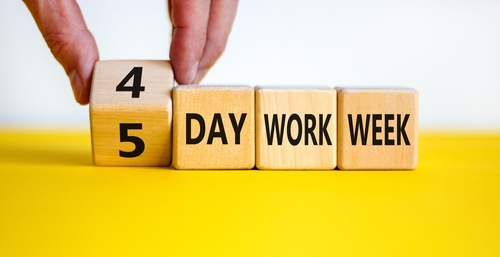The 4-day workweek (32 hours at 8 hours/day x 4 days/week) recently has come back into major discussion. The latest brick in the wall is researchers at Boston College, think tank Autonomy, and Oxford and Cambridge Universities wrapping up the largest research study to put that question to the test, with 61 companies and 2,900 employees in the United Kingdom participating in a pilot program for a 4-day workweek.
The results were promising: More than a third of employees reported feeling less stressed, 48% were more satisfied with work, 46% had less fatigue, 40% got better sleep, and 71% felt less workplace burnout.
The Idea Isn’t New (Some History)
In reality, people have been kicking tires on this idea for a long time. We already have some models in place: 4 days/week x 10 hours/day (40), 80 hours across 9 days, etc. Hundreds of companies use these.
Companies like Dell were doing shortened workweeks in the early 2000s. Then, after the 2008 recession, as the economy stabilized, companies began trying out the 4-day week as another “perk.” Treehouse was one of the notable companies that was getting media attention in the early 2010s for 4-day policies.
Later in the decade, a bit before COVID, more companies were doing it (but still not many), and Microsoft did a pilot program with its Japanese workers. The big headline from the pilot was 40% more productivity and 23% less energy costs.
It’s important to stop here and look a bit critically at the Microsoft program. It was just Fridays in August. If you’ve ever been in an office on Fridays in August, it can be a ghost town. The Microsoft study got a lot of attention, but the design was a bit flawed.
During COVID, obviously our models around work (and what we want from work) changed quickly. Employees—and some managers—realized they could get a lot done in 4 days if they weren’t being called into meetings and other “Hey, got a minute?” tasks. We’re still figuring out all the work repercussions of COVID.
The Logistics of Implementing a 32-Hour Workweek
- Bosses need to be better able to define “productivity” for roles on their team, and then they can learn what roles are OK to work 4 days/week.
- You can’t give everyone Fridays off because of client needs, so logistically, you need a rotating schedule.
- You can try models such as no Friday afternoons except for one coverage person.
- Assign one person to be the “32-hour scheduler,” and adjust people accordingly.
Beyond these bullet points, the biggest element is that companies need to lose a “fear mindset,” which is generally what’s prevented the 32-hour week innovation in the past. Leaders fear 32 hours means less will get done and less productivity will be achieved, which means less margins and growth. It doesn’t mean that. Oftentimes, people working less achieve more within the time they work—and that’s what was happening in the Microsoft and Autonomy studies mentioned above. And in fact, 32 hours is the minimum to provide health insurance to employees. You might see fewer health issues because people will feel less burnt out (honestly).
It’s an achievable idea and one that deserves attention and a trial, but you will need to shift your internal mindset away from fear and control and toward investing in employees and their time.
This can be one of the most impactful trials on your culture because you’re sending a message that you trust employees and intend to treat them like adults. If they get work done in 32 hours, awesome. If they don’t, you have the right to have a discussion with them and perhaps set a new plan. And you’re giving them time back as the business still hums along. It’s truly a potential win-win-win.
Jessica Kriegel is the Chief Scientist of Workplace Culture for Culture Partners, leading research and strategy in best practices for driving results through culture. For 15+ years, Kriegel has been guiding global, national, Fortune 100, and other organizations across finance, technology, real estate, and healthcare industries on the path to creating intentional cultures that accelerate performance.

